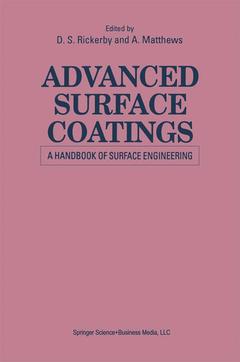Advanced Surface Coatings: a Handbook of Surface Engineering, 1991
Langue : Anglais
Auteur : Matthews A.
Coordonnateur : Rickerby David

The past decade has seen a rapid development in the range of techniques which are available to modify the surfaces of engineering components. This in tum has led to the emergence of the new field of surface engineering the design of a composite system (coating plus substrate) that produces a performance which cannot be achieved by either the coating or substrate alone. With this expansion comes the problem of deciding on the correct surfacing technology for a given application. Clearly, to take full advantage of the benefits which surface engineering offers, there is a need to explain, in a structured way, the basic features and interrelationships of the most recently developed coatings and treatments. Advanced Surface Coatings satisfies this need by providing a concise and authoritative state-of-the art review of surface engineering. In chapter 1 the reader is provided with an insight into the surfacing technology appropriate for a given function. Chapter 2 reviews the principles of plasma generation (a theme which is central to many of the advanced surface treatments and coatings) and forms a solid foundation for the chap ters which follow. Chapters 3 to 10 each discuss the general principles on which the technology is based, followed by an appreciation of specific properties and application areas for materials treated by each particular method. These chapters cover ion implantation, ion-assisted coatings, evaporation, sputtering, physical vapour deposition, chemical vapour deposi tion, thermal spraying, and laser treatments.
1 Introduction.- 1.1 Surface engineering: the key to optimised performance.- 1.2 The main surface engineering technologies.- 1.3 Coating structure and characterisation.- References.- 2 Use of plasmas in deposition technologies.- 2.1 Introduction.- 2.2 Processing plasmas.- 2.3 Plasmas in the presence of magnetic fields.- 2.4 Microstructure of sputter deposited films.- 2.5 Conclusions.- References.- 3 Ion implantation and ion-assisted coating.- 3.1 Introduction.- 3.2 Beam-induced processes.- 3.3 Tribological applications.- 3.4 Applications to corrosion resistance.- 3.5 Equipment.- 3.6 The economics of ion beam processing.- 3.7 Conclusions.- References.- 4 Evaporation.- 4.1 Introduction.- 4.2 Practical aspects of evaporation processes.- 4.3 Coating thickness distributions and uniformity.- 4.4 Evaporation principles.- 4.5 Further considerations in electron beam evaporation.- 4.6 Selected applications for evaporative techniques.- 4.7 Conclusions.- References.- 5 Sputter deposition.- 5.1 Introduction and historical perspective.- 5.2 Basic aspects of sputtering.- 5.3 Sputtering techniques.- 5.4 Plasma characteristics and ion bombardment.- 5.5 Process control.- 5.6 Applications of sputtered hard coatings.- 5.7 Industrial coating systems.- 5.8 Future trends.- References.- 6 Plasma-assisted physical vapour deposition.- 6.1 Introduction.- 6.2 The DC-diode argon discharge.- 6.3 Bombardment of the cathode in argon discharges.- 6.4 Practical ion-plating discharges.- 6.5 Practical considerations and system details.- 6.6 Applications and case studies.- 6.7 Conclusions.- References.- 7 Thermally activated chemical vapour deposition.- 7.1 Introduction.- 7.2 Principles of CVD.- 7.3 The CVD system.- 7.4 CVD reactors.- 7.5 Design of a CVD process.- 7.6 Adhesion.- 7.7 Rate-limiting steps.- 7.8 Nucleation.- 7.9 Deposition mechanisms.- 7.10 Morphology and microstructure.- 7.11 Applications of the CVD technique.- 7.12 Summary and concluding remarks.- References.- 8 Plasma-assisted chemical vapour deposition.- 8.1 Introduction.- 8.2 Discharge chemistry and physics.- 8.3 PACVD equipment requirements.- 8.4 Applications of PACVD.- 8.5 Summary 215.- References.- 9 Thermal spraying.- 9.1 Introduction.- 9.2 Thermal spraying.- 9.3 Substrates and surface preparation.- 9.4 Coating properties.- 9.5 Applications.- 9.6 Summary.- References.- 10 Laser surface treatment.- 10.1 Introduction.- 10.2 Practical aspects of laser processing.- 10.3 Laser techniques.- 10.4 Current and future applications of laser processing.- 10.5 Conclusions.- References.- 11 Characterisation of coatings and interfaces.- 11.1 Introduction.- 11.2 Electron spectroscopies.- 11.3 Electron microscopies.- 11.4 Ion spectrometry and microscopy.- 11.5 Photospectroscopies and microscopies.- 11.6 Conclusions.- References.- 12 Evaluation of coatings.- 12.1 Introduction.- 12.2 Mechanical property assessment.- 12.3 Summary and future developments.- References.- 13 Market perspective and future trends.- 13.1 Introduction.- 13.2 Future directions in surface engineering.- 13.3 New materials and future markets for surface engineering.- References.
Date de parution : 11-2012
Ouvrage de 368 p.
15.2x22.9 cm
© 2024 LAVOISIER S.A.S.



